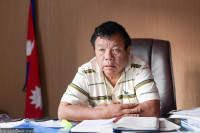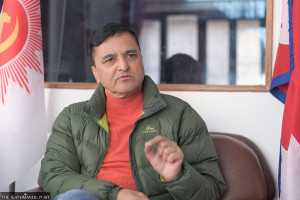Interviews
‘Inflation will remain high in the foreseeable future’
Economist and former executive director of the Nepal Rastra Bank Keshav Acharya on the state of the economy.
Krishana Prasain & Prithvi Man Shrestha
Keshav Acharya is an economist and a former executive director of the Nepal Rastra Bank. He also served as chief economic advisor at the Finance Ministry and has worked in several think tanks on economic policies. With the national economy facing multiple headwinds, Krishana Prasain and Prithvi Man Shrestha from the Post caught up with Acharya to discuss the state of the economy. Excerpts:
What is your assessment of the current state of the country’s economy?
Though our economy is not in great shape, luckily, we are doing better compared to Sri Lanka, Bangladesh and Pakistan. Our economic growth is still on a positive trajectory and inflation is not that high, compared to these three South Asian countries. But this does not mean that everything is fine. The inflation has doubled to more than 8 percent on a year-on-year basis and our external sector is still very fragile.
Our balance of payments entered into a positive trajectory just because of the severe import control measures. The financial sector is also in trouble for the first time, after several years. In the past, we used to witness liquidity crunch for 2-3 months, but this time around, the problem has sustained for longer. The base rate of all the banks is in double digits and hardly anyone can take loans from the banks at less than 14 percent interest rate. Non-performing assets of banks have been increasing, which means they have to make provisioning from their resources. With deposits not coming to the banks, they are relying on short-term liquidity in the form of repo and standing liquidity facility extended by the central bank.
There is a demand for long-term loans, but the banks are in a position to offer only short-term loans. Another unusual thing that has happened in the financial sector is that the money withdrawn from the banking system for Dashain and Tihar didn’t return to the banks, as expected. I was hopeful that the market would be flush with liquidity during the elections, but no such thing happened.
So, the external sector is structurally vulnerable, while the financial sector too is in a similar state. With construction activities slowing, demand for cement, iron and steel have also slumped. In agriculture, farmers have for long struggled to get chemical fertilisers, which will hit agricultural production. On the fiscal side, the government is failing to raise revenues as per the target and collected revenue is not enough even to sustain recurrent expenditure.
How do you define structural vulnerability in the external sector?
The major component of Nepal’s external sector is remittance, which is very volatile. Remittances are not that sustainable, but they have been supporting the external sector of our economy for the past 25 years. But for the past 3-4 years, remittances have not been able to support the external sector adequately because of surging imports. The inflow of foreign direct investment (FDI) is low despite the introduction of new laws and rules to encourage investment. If we look at the data of the central bank, the amount of repatriation is higher than the FDI inflow. The contribution of foreign investment in helping the balance of payments is insignificant. Boosting exports would have been a better option. That has not happened. The contribution of tourism is also limited. The current marginal improvement in the balance of payments is not because of the increase in foreign currencies, but due to the restrictions on imports. As the government has decided to lift import restrictions, foreign currency reserves may again dwindle.
There used to be a short-term liquidity crunch in the banking system, but it has been prolonged this year. Why?
As massive borrowings were made after the Covid-19 pandemic with the central bank rescheduling and restructuring loans, the money went into sectors like real estate and the share market rather than the productive sector. The remittances, which are a major source for deposits, have been volatile. They are not entering the country as expected as they are being taken away at the source countries. The trend of remittances being sent home through illegal channels like Hundi is still prevalent. On the other hand, strict Know Your Customer (KYC) provisions imposed on banks and financial institutions are also discouraging potential depositors. Because of inflation, which is running at more than 8 percent, people don’t want to deposit their money. They get an interest rate of 12 percent for the deposits, while more than 8 percent inflation means the real gain for the depositor is just over 3 percent.
The government recently decided to lift the ban on imports. International institutions like the International Monetary Fund (IMF) also reportedly pressured the government to lift the ban. How do you view the government's decision?
With the target revenue not being collected, the government feared it wouldn’t be able to run its operations and decided to lift import restrictions. I think import control measures should continue for some more time as the external sector continues to be vulnerable. The government may have to return to import restrictions if the situation of the external sector of the economy worsens as a result of lifting of the import ban. Even without the ban, there has been a control on imports due to the liquidity crunch in the banking system. Without loanable funds, the banks have not been able to finance the import of goods, whose bans were lifted starting mid-December. As long as we can sustain it, the state should not interfere in free trade.
As far as reported pressure from the IMF is concerned, we should let the IMF know the situation of our foreign exchange reserves of $9 billion and the options we have to cover the shortfall, as most of our foreign exchange is spent on imports. In fact, we have little control over foreign exchange and we are heavily reliant on remittances. Our debt to GDP ratio has also gone up to 42 percent from around 38 percent in 2017. It is not a matter of worry if the debt is used for capital formation. When the debt to GDP ratio increased massively after 2016-17 due to borrowings for post-quake reconstruction, the capital formation rate declined in the private and public sectors. So, we have to be concerned about these vulnerabilities.
Inflation is hitting general lives hard. How long do you think the situation of high inflation will continue?
Currently, there is inflation of more than 8 percent. Inflation in Nepal is highly dependent on the external situation. Nepal is an import-dependent country and has been suffering from global price rises. Particularly, the prices of food and fuel have increased. Likewise, the price of chemical fertilisers has also surged. Post-Covid, the global supply chain has not normalised, with the war in Ukraine affecting prices further. Currently, the cost of production, insurance and freight have all gone up, which fueled inflation globally. On the other hand, because of Nepal’s pegging of its currency to the Indian rupee, our rupee has also weakened against the US dollar along with the Indian currency. All these factors have contributed to the rise in the prices of imported goods, making life difficult for Nepalis. With the western countries fixing the maximum price for Russian oil, it is likely to contribute to a continued spurt in global oil prices which would further fuel inflation. Nepal will continue to see high inflation for the foreseeable future.
Industries are reporting massive production cuts. Are we headed towards an economic recession?
We may not go into recession soon, but we need to be careful. Negative economic growth for two consecutive quarters is defined as a recession. Our growth rate of 4-5 percent, lately, has been driven mainly by the recovery in the service sectors, like tourism, after the Covid-19 pandemic.




 12.12°C Kathmandu
12.12°C Kathmandu













